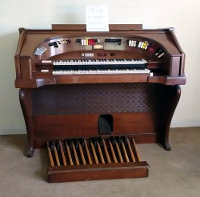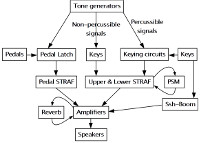Wurlitzer 4500!

I got a new electronic organ to play with! This one is a Wurlitzer 4500. Around the end of 2016 a relative spotted a big, old electronic organ in a local thrift store. After I checked it out the next day -- to make sure it worked at least a little bit -- the family jumped into action and a couple hours later it was in our living room! The design dates to the 1960s, and while I can't find a manufacturing date on this particular organ, I think it was made in the 60s as well. This organ model was one of Wurlitzer's first forays into entirely solid-state electronic organs. They made a few different models in the 1960s with the same innards, and what I have is a 4520, with a nice curved console. It has two 61-key manuals, a 25-pedal pedalboard, and about 23 sound-producing stops in total.
The organ was in fairly good shape when I got it, considering its age. It turned on without anything obviously going wrong, like smoke or burning smells. The upper manual played and sounded fine, and many of the pedals played but were a bit soft. The lower manual did not make any sound. Half of the console lights lit. The console was dirty but otherwise not too beat up -- some scratches and dings, but structurally sound. If the organ hadn't turned on at all I don't think I would have gotten it, but this much working was a good enough starting point for me.
It's interesting to compare this organ to the previous analog organ I dealt with, the Rodgers Cambridge 220-II, which was a bit newer dating from the 1970s. This Wurlitzer is a theater organ, so it has some interesting features not found on the Rodgers church organ, like Spectratone (a Leslie-like rotating speaker), vibrato, reverb, sustain, pizzicato, and "Ssh-boom" (cymbal and drum sounds triggered by pressing keys -- no automatic rhythm). The Wurlitzer has twelve master oscillators while the Rodgers has one per note (about 200 in all, since they have to support the celeste stops as well). I imagine the master oscillators were a lot less expensive to produce and maintain, and with the size of the electronics in the Wurlitzer they would have had to make the cabinet larger if they were to have an independent oscillator for each note!
Wurlitzer is out of the business of making organs -- in fact, I think they're out of business entirely, though the name is owned by some other company. But their stock of spare parts and other items are still available through Morelock's Organ Parts. (Morelock's has very little Web presence; I think they're still in business.) I got a service manual from them, including a full set of schematics. In fact, the manual is mostly just schematics, plus some troubleshooting tips. While the schematics are vital, some explanation of how the organ functions and is laid out would have been helpful too. The first thing I did with this organ was just sit at the back of the organ and try to match up the hardware I could see with the circuit diagrams, and then figure out how everything interconnected.
Perhaps you, dear reader, are in a similar situation -- a new owner of a Wurlitzer 4500 or a prospective buyer of one. Below are a couple of annotated images showing where most of the major electronic components are, and a quick diagram showing how signals flow through the electronics of the organ. I'm pretty sure these are correct, but I'm happy to take corrections if you happen to know this instrument and see a mistake! Also included is a block diagram showing, roughly, how signals move through the major components of the organ. Again, I'm pretty sure it's correct, but please let me know if you see a mistake or some major element missing!
The organ has two main signal paths for the keyboards. "Non-percussible" signals are connected directly between the appropriate tone generators and keys; when a key is pressed it connects that signal to a bus bar running underneath the keyboard, which carries signals directly into that keyboard's STRAF unit. The STRAF (Stop Tab Rail And Filter) units are responsible for shaping the waveforms of the signals that arrive there, depending on which stop tabs are pressed, to produce the various timbres of the different stops. "Percussible signals" go from the tone generators to keying circuits, one per note in the organ. Each keying circuit is connected to another contact under the appropriate key(s) on one of the keyboards. The bus bar associated with these contacts carries a steady voltage of about +170V, so when a key is pressed it feeds that voltage to its keying circuit, which activates it. (The keying circuits make the sustain effect possible -- when sustain is activated for a keyboard, a capacitor is connected to each keying circuit as well. When a keying circuit is activated it charges that capacitor as well, and the gradual discharge of the capacitor after the key is released produces the sustain. The chimes effect does the same thing with additional sets of capacitors.)
The pedal's signals go through a different path. The lower two octaves of notes from the tone generators go to a pedal latch circuit that allows a signal through when one of the pedals is pressed. The pedal latch is unique because it allows no more than one pedal's signal through at a time, making the pedals monophonic. The output from the latch circuit goes through one or two more stages of frequency dividers to drop the note one or two more octaves before feeding into the pedal STRAF. Each keyboard's STRAF unit drives one amplifier, and the signal from the pedal STRAF is split to both amplifiers.
These images relate to the stock organ. I've since changed some elements, some in the course of fixing broken components and some to work towards my goal of eventually MIDIfying the organ. More on that in articles to come!



Comments
Short= smaller value capacitor
Medium= larger value capacitor
Long= Both capacitors in parallel
Wurlitzer housed the PC boards the way they did in the sustain units because they used a "whisker contact" method on a long rotary shaft. Some organs used red 'bicycle cable' type lines to the rocker switches for mechanical rotation of the shaft. Other organs ( typically post '65 4500.4502, 4300, 4300D) used an electric solenoid. Personally I like the idea of the solenoid because you can easily put a knee lever activated Sostenuto make/break contact switch under the key desk for instant on/off of the Sustain, for either or both manuals.
Always be sure the 12" speaker ( the visible one on the left) has good solid paper along the edge of the cone where it meets the cardboard surround. If it is split it can cause the amp to fail. Typically the diodes in the amp blow.
I do hope you keep your 4520 going instead of disconnecting it all for midi, or worse, removing everything. Combining analog original sound with an external MIDI sound module with your hauptwerk or whatever, it allows you to keep your organ stock and simply add little contact switches on the back of the tabs. It's noninvasive.
The 4XXX organs were designed using a real Wurlitzer pipe organ. Look at the " Internet Archive Wurlitzer 4300 Brochure " for pics of the lab with the theater organ and the engineers. The 4000 series are very accurately represented in the analog electronic oscillator format. Which is a beautiful format! Just listen to the great Rodgers analog electronic individual oscillator Electronic Theater Organs. Analog oscillators and analog voice coil speakers ( which 99% of speakers are) are a match made in heaven! That said, if you do go digital check out the great Magnepan Magneplanar speakers. They are perfect for Hauptwerk. Low pressure, large footprint. Very conducive to how acoustic instruments operate. Also because they are low pressure you can crank up magneplanar speakers and go in the next room and hardly hear it. TIP: find a pair of "rattling" Magneplanar speakers. It's just the black tar adhesive that needs reapplied. Magnepan will sell it to you cheap, and even fully rebuild and recover many models for about $500 a pair. The early SMgA's are often avail cheap and they sound excellent.
RSS feed for comments to this post